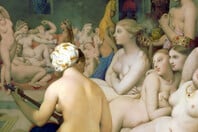"Χάρη στην πρόσφατη μελέτη του Gary Ferguson σχετικά με την queer υποκουλτούρα στην Αναγεννησιακή Ρώμη, διαθέτουμε πλέον περισσότερη πληροφορία στην προσπάθειά μας να δώσουμε μορφή στις ομόφυλες ερωτικές σχέσεις εκείνης της εποχής."το βιβλίο είναι το εξής:Same-Sex Marriage in Renaissance Rome: Sexuality, Identity, and Community in Early Modern Europe Hardcover – July 9, 2016https://www.cornellpress.cornell.edu/book/9781501702372/same-sex-marriage-in-renaissance-rome/Same-sex marriage is a hotly debated topic in the United States, and the world, today. From the tenor of most discussions, however, it would be easy to conclude that the idea of marriage between two people of the same sex is a uniquely contemporary phenomenon. Not so, argues Gary Ferguson in this remarkable book about a same-sex wedding ceremony in sixteenth-century Rome. The case in question involved a group of mostly Spanish and Portuguese men, arrested and executed in Rome in 1578, said to have performed same-sex wedding ceremonies in one of the city’s major churches. We know about the incident from a number of sources, including the travel journal of the French essayist Michel de Montaigne.Several substantial fragments of the transcript of the men’s trial have also survived, along with copies of their wills. Making use of all these documents, Ferguson brings the story to life in striking detail. He reveals not only the names of the men but also where they lived, how they were employed, and who their friends were. In particular, he unearths a surprising amount of detail about the men’s sex lives, and how others responded to this information, which allows him to explore attitudes toward marriage, sex, and gender at the time. Emphasizing the instability of marriage in premodern Europe, Ferguson argues that same-sex unions should be considered part of the institution’s complex and contested history._____________Ενδιαφέρον φαίνεται:"A microhistory with a bite, this fascinating and richly detailed study of a literally queer 'marriage' in early modern Rome involving a group of men who ran afoul of the papacy and local authorities challenges virtually all the current givens about premodern male/male sex and especially what has become a Foucauldian orthodoxy. Melding a close reading of archival documents and a wide-ranging reading of literary accounts, it offers a stimulating rethinking of marriage, sexual identity, sexual subcultures, and an ideal of mutual pleasure in sex―and not just in the premodern period, for this book engages intelligently and provocatively with modern debates on these subjects as well."(Guido Ruggiero, University of Miami, author of The Renaissance in Italy: A Social and Cultural History of the Rinascimento)_____________Επίσης έχει γράψει αυτό:Queer (Re)Readings in the French Renaissance: Homosexuality, Gender, Culturehttps://www.amazon.com/Queer-Readings-French-Renaissance-Homosexuality/dp/0754663779_____________"Είναι σα να λέμε "η υποκουλτούρα τον rave parties" αναφερόμενοι στη διονυσιακή λατρεία."...υπερβολές, απλά για την μπεις. Αφενός μεν (και κυριότερον) η λέξη «queer» έχει, πλέον, πλήθος διαφορετικών μικροεκφάνσεων νοηματικά και validly μπορεί να χρησιμοποιηθεί -αν ξέρει, κανείς, για τι μιλάει- (https://www.merriam-webster.com/dictionary/queer) αφετέρου -και χωρίς να έχει τόσο σημασία αυτό στην πρώτη εννοιολογική της γκάμα είναι «μαζί μας» μισή χιλιετηρίδα τώρα.First Known Use of QUEER (circa 1500):"differing in some way from what is usual or normal : ODD, STRANGE, WEIRD"Since it first showed up in English about 1513, “queer” has always meant something not normal, something peculiar, something odd. Counterfeit money was “queer”; someone who is sick might say they “feel queer”; playground bullies would call someone “queer” without knowing or intending any sexual connotations.The Oxford English Dictionary says the noun “queer” was first used to mean homosexual by the Marquess of Queensbury, in 1894. The Concise New Partridge Dictionary of Slang says the adjective “queer” began to mean “homosexual” about 1914, mostly in the United States, and notes it was “derogatory from the outside, not from within,” a hint that it was being embraced as a self-description even then.
























